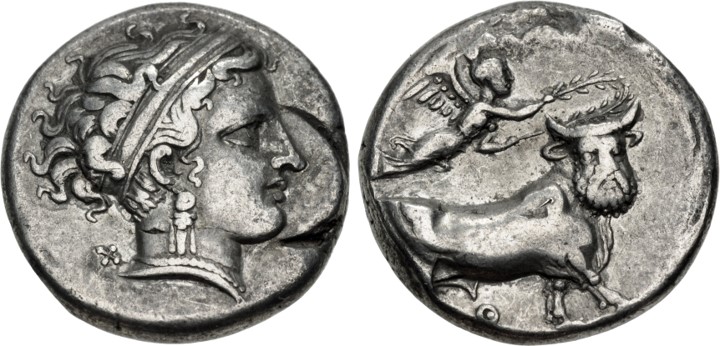320 BCE - 300 BCE | NEOΠOΛITHΣ
Overstriking coin
Neapolis_Classical_Numismatic_Group, _EA_562, _15_May_2024, _12.jpg
[1]
Overstruck variety
Corinth Aphrodite Pegasus right.jpeg
[2]
|
|
Sale(s)Sale(s) ᵖ:
|
Classical Numismatic Group, XXXII, 7 Dec. 1994, lot 1004 (part of) = Classical Numismatic Group, EA 562, 15 May 2024, 12
|
| Private collection(s)Private collection(s) ᵖ:
|
Ex Economopoulos Numismatics inventory 12001705 (ND); Property of "A Private European Investment Consortium"
|
|
Description
| ObverseInscription or printing placed on the obverse.:
|
Diademed head of nymph to right, wearing triple-pendant earring and pearl necklace, X behind neck
|
ReverseInscription or printing placed on the reverse.:
|
NEOΠOΛITHΣ (Greek) Man-headed bull walking right, above, Nike flying right, placing wreath on bull's head, Θ below, ethnic on raised exergual line
|
Mint and issuing power
| MintIdentifies the place of manufacture or issue of a numismatic object.:
|
Neapolis
|
Ancient regionAncient region.
|
Campania
|
Modern countryModern country: Italy
|
AuthorityIdentifies the issuing power. The authority can be "pretended" when the name or the portrait of X is on the coin but he/she was not the issuing power. It can also be "uncertain" when there is no mention of X on the coin but he/she was the issuing power according to the historical sources:
|
|
Chronology
| FromIdentifies the initial date in a range assigned in a numismatic context. 320 BCE toIdentifies the final date in a range assigned in a numismatic context.. 300 BCE
|
Hellenistic 323-30 BC  periodTime period of the numismatic object. periodTime period of the numismatic object.
|
Physical description
MetalThe physical material (usually metal) from which an object is made.: Silver 
|
WeightWeight of the numismatic object (in grams). in grams: 7.137.13 g <br />7,130 mg <br />
|
DenominationTerm indicating the value of a numismatic object. Examples: tetradrachm, chalkous, denarius.: nomos
|
AxisDescribes the directional relationship between the obverse and reverse of a numismatic object.: 77 mm <br />0.7 cm <br />
|
| DiameterDescribes diameter of an object (in mm).: 1919 mm <br />1.9 cm <br />
|
|
References
Description
| ObverseInscription or printing placed on the obverse.:
|
Pegasus flying right
|
ReverseInscription or printing placed on the reverse.:
|
Head of Athena right, wearing a Corinthian helmet
|
Mint and issuing power
| MintIdentifies the place of manufacture or issue of a numismatic object. ᵖ:
|
Corinth
|
Ancient regionAncient region. ᵖ
|
Peloponnesus
|
Modern countryModern country: Greece
|
AuthorityIdentifies the authority in whose name (explicitly or implicitly) a numismatic object was issued. ᵖ:
|
|
Chronology
| FromIdentifies the initial date in a range assigned in a numismatic context. 410 BCE toIdentifies the final date in a range assigned in a numismatic context.. 340 BCE
|
Classical 480-323 BC  periodTime period of the numismatic object. periodTime period of the numismatic object.
|
Physical description
| DenominationTerm indicating the value of a numismatic object. Examples: tetradrachm, chalkous, denarius. ᵖ:
|
stater 
|
StandardStandard. ᵖ:
|
Aeginetic
|
References
References
- ^ Fisher, Joan E. (1969), Sylloge Nummorum Graecorum. The Collection of the American Numismatic Society. Part I : Etruria-Calabria, New York, 39 pl., 1618 n°
- ^ Rutter N. Keith et alii (eds.) (2001), Historia Numorum Italy, London, xvi, 223 p., 43 pl.
- ^ Hoover, Oliver D. (2018), The Handbook of Greek Coinage Series, Volume 1. Handbook of Coins of Italy and Magna Graecia, Sixth to First Centuries BC., Lancaster-London, 2018, lxi, 527 pages, 23 cm
- ^ Calciati, Romolo (1990), Pegasi, Mortara, Edizioni I.P..
- ^ Hoover, Oliver D. (2014), Handbook of Greek Coinage Series 4. Northern and Central Greece : Achaia Phthiotis, Ainis, Magnesia, Malis, Oita, Perrhaibia, Thessaly, Akarnania, Aitolia, Lokris, Phokis, Boiotia, Euboia, Attica, Megaris and Corinthia, sixth to first centuries BC, Lancaster, lxxi, 563 p.

